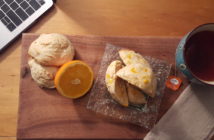Conserve. Preserve. Just plain jelly. Whatever you choose to call it, the precise origin of jam remains a matter of historical debate. Jams have a rich history and are appreciated worldwide for their fragrance and fruity taste. Jam-making probably began in the Middle-East where cane sugar grew naturally.
It is believed that returning Crusaders first introduced jam to Europe; by the late Middle Ages, jam had become popular. Jam-making in Europe can be traced back to the 16th century following the arrival of the Spanish in the West Indies who had been preserving fruits for generations. Jams were a kingly delicacy and many a royal sweet tooth demanded an array of fruit flavors preserved with sugar. Chroniclers of more regal eras describe the magnificent feasts of Louis XIV, which always ended with fruit preserves served in silver dishes. Each delicacy served at Versailles was made with fruit from the king’s own gardens and glasshouses.
It’s a labor of love, but for those who love making jams and jellies it is an art form that is well worth the effort. There’s seemingly endless new ways to infuse flavor into your favorite fruit jellies and jams—but adding your favorite tea flavors requires just the right amount of preparation and taste combination. The possibilities seem endless. The result? A scone’s best friend.
Green Tea Jam
Adapted from WebMD recipe from Foodily.com
Makes 12 servings.
Ingredients
- 2 teaspoons green tea
- 16 ounces water
- 2 pounds fresh nectarines, peeled, pitted and roughly chopped
- 2 pounds fresh peaches, peeled, pitted and roughly chopped
- 1/4 cup brown rice syrup
- 1/3 cup crystallized ginger
Method
- Steep tea in boiling water for 3-5 minutes. Drain and place into a heavy saucepan with all ingredients except ginger. Bring to a boil, then reduce heat and cook for 20 minutes.
- Add ginger. Cook for another 20 minutes. Remove from heat and set aside to cool. The mixture will thicken when cooled.
Sweet Tea Jelly
Adapted from The Runaway Spoon
Sweet tea jelly is great on toast or biscuits and amazing in the center of a thumbprint sugar cookie. But for a little something different, use it as a glaze for chicken wings or a pork roast.
Makes 3 half-pints, or 5 4-ounce jars.
Ingredients
- 4 tea bags (for iced tea, like orange pekoe)
- Big handful of mint leaves
- 6 cups water
- 2-1/2 lbs golden delicious apples
- 2 lemons, juiced
- 4 cups sugar, more or less
- 1/2 cup mint leaves, finely chopped
Method
- Place the tea bags in a large measuring jug and add a handful of mint leaves. Pour over 4 cups boiling water and leave to brew until dark amber, about 4 minutes. Remove the tea bags and leave to cool.
- Cut the apple, peel, core, seeds and everything, into small chunks and place in a large heavy Dutch oven. Pour over the brewed tea with the mint and the remaining 2 cups water. Bring the mixture to a boil, lower the heat to medium and simmer for 30 minutes, until the apples have broken down and are soft and mushy. Use a wooden spoon or a potato masher to crush the fruit.
- While the apples are cooking, line a sieve with cheesecloth, muslin or a clean 100% cotton handkerchief and place it over a large bowl. When the apples have cooked and you’ve mashed the fruit, carefully pour everything into the sieve. Leave the pulp to drip juice overnight. Cover the sieve and bowl with a tea towel, but do not press down on the pulp, or you’ll end up with cloudy jelly.
- Place a small plate in the freezer to do a set test when the jelly is done.
The next day, discard the pulp and measure the juice produced, from 4 to 6 cups. Pour the juice into a large Dutch oven and bring to a boil. Stir in the lemon juice and ¾ cup of sugar for every one cup of juice. Stir until the sugar has dissolved. Stir in the chopped mint leaves. Bring to a boil and cook, stirring frequently, about 10 to 15 minutes, until the jelly is thick and streams in a sheet from a spoon lifted out of it.
When the jelly has cooked down and is thickened, pull that little plate out of the freezer and spoon a little jelly onto it. Leave to set for a minute, then tilt the plate. If the jelly stays put, or only runs a little bit, it’s ready to go. Run a finger through the jelly on the plate if the two sides stay separate and don’t run back together.
While your jelly is cooking, get a boiling water canner or big stockpot of water going. When the jelly is almost ready, pour some boiling water over the lids to your jars to soften the seals and set aside.
When the jelly has met the set test, fill the jars. Ladle the jelly into a large measuring jug for easy pouring. Fill each of your jars with the jelly, leaving a 1/2 inch head space. Dry the lids with a clean paper towel and place on the jars. Screw on the bands, then process the jars for 5 minutes in a boiling water bath. If you have a bit of extra jelly, scoop it into a refrigerator container and keep in the fridge for up to a week.
When the jars are processed, leave to cool on a towel on the counter. The processed jars will keep for a year in a cool, dark place. Don’t forget to label your jars!
Rose Petal Hibiscus Tea Jelly
Adapted from Cupcake Rehab
This unique jelly is made using some flower-based tea and rose petals. Try Hibiscus tea bags from Davidson’s. The rose petals add a subtle, rosy flavor. A drop of rosewater in the tea before cooking would work too. Or if you’ve got hibiscus, then use hibiscus petals! The petals float to the top, so when you open the jelly; you’ll see them at the surface. You can eat them, scrape them off and toss them, or save them.
Makes about 1 8-oz. jar with some overflow
Ingredients
- 4 Davidson’s Tulsi Hibiscus tea bags
- 1 cup plus two tablespoons water
- 1 1/2 cups plus two tablespoons sugar
- 2 tablespoons plus 1 teaspoon Certo liquid pectin (or 1/3 cup apple pectin)
- 2 tablespoons fresh strained lemon juice
- 4-6 large unblemished rose petals (from roses not chemically treated)
Method
- Sterilize and keep warm two 8-oz. jars and one 4-oz. jar (for overflow, just in case). Place the lids in a bowl of hot water and set aside.
- In a bowl of water, delicately swirl the rose petals to remove any bugs or excess dirt. Remove gently and drain on paper towels. Add the tea bags to the 1 3/4 cups water in a medium saucepan. Bring to a rolling boil, then remove from the heat, add the rose petals, and let steep for 5 to 6 minutes. Drain and toss the tea bags and petals (or add the petals to the jars; they’ll float).
- Add the pectin, lemon juice and sugar to the tea. Bring to a boil and cook over high heat until it reaches 220° F on a candy thermometer, or passes the freezer plate test, about 25 to 30 minutes.
- Pour into prepared jars, leaving 1/4″ headspace. Wipe rims and place lids and bands, turning only to fingertip tight.
- Process in a waterbath canner for 5 minutes. Remove onto a clean tea towel and do not disturb for a day. Check seal. Use any that aren’t sealed immediately.
Sugar-Free Hibiscus Rosella Jam
Adapted from Foodista.com
Hibiscus goes into a lot of our favorite tart and tangy teas, but this recipe lets you put it on the plate, too! Red Zinger shortcakes, anyone?
Ingredients
- 2 cups dried hibiscus flowers with any tough parts removed (sometimes you get little woody bits attached)
- 1 1/2 cups sweetener (for example, Candarel)
- 2 1/2 cups sugar-free cranberry juice
- 1/2 teaspoon agar-agar powder
Method
- In a large saucepan combine the hibiscus flowers, sweetener and cranberry juice. Boil for 45-50 minutes (it takes some time for the flowers to soften but leave around a cup of moisture in there).
- Add the agar-agar powder.
- When the flowers are soft allow the mixture to cool and transfer to a blender. Blend the hibiscus until it becomes pureed.
- Transfer to sterilized jam jars and refrigerate. Consume within 3 weeks.
Peach Oolong Jelly
Adapted from Food In Jars
This jelly is a nicely set, delicately flavored delight. It works with cheese and would also be fantastic smeared on a scone with a mug of milky tea.
Yield: Makes 1 1/4 pints
Ingredients
- 2 cups sugar
- 2 cups water
- 5 bags Orchid Oolong tea
- 4 large peaches, sliced
- 2 tablespoons powdered pectin
Method
- Prepare 2 1/2 pint jars and 1 1/4 pint jar. Bring a boiling water bath to a boil.
- In a large pot, combine sugar and water. Bring to a simmer and stir until the sugar has dissolved. Add 4 tea bags to pot and let them simmer for 5 minutes.
- When time is up, remove tea bags and add sliced peaches. Let simmer for approximately 10 minutes, tasting regularly to monitor the intensity of flavor. When the balance of peach and oolong tastes good to you, strain the liquid through a fine mesh sieve, pressing gently on peaches to remove as much liquid as possible.
- Return syrup to pot and add 2 tablespoons powdered pectin. Bring to a rapid boil and monitor temperature. When the jelly liquid reaches approximately 220 degrees, it is done.
- Remove pot from heat and pour jelly into prepared jars. Wipe rims, apply lids and rings and process in a boiling water canner for 10 minutes.
- When time is up, remove jars from canner and let cool on a dish towel. When jars are cool, remove rings and test seal. Store any unsealed jars in the refrigerator. Unopened jars of jelly will keep on the shelf for up to one year.




